How to Pay for Your New Roof with “No Money” (10 Roof Financing Options)
One of the first questions homeowners have when they think about a roofing project is in regard to how to pay for a new roof. There are situations where the project can’t be planned in advance, which means the homeowner has no time to save up for the roof, but they desperately need a new one to protect their home. If you're wondering how to pay for a roof with no money, we’ve got answers here.

Replacing a roof is one of the more expensive home improvement projects a homeowner takes on, but it’s an important one as the roof protects the home and everything in it, from lives to property. If you need a new roof but can’t afford to pay for it upfront, you can get what you need now and pay for it over time with financing. In an ideal world, financing would never be needed, but in some situations financing is the perfect solution.
Table of contents:
- HOW TO PAY FOR YOUR ROOF REPLACEMENT

- ROOF FINANCING EXPLAINED

- HOW MUCH DOES A NEW ROOF COST?

- WHY SHOULD YOU FINANCE YOUR ROOF REPLACEMENT PROJECT?

- THE BENEFITS OF FINANCING NEW ROOF

- HOW TO SELECT THE BEST WAY TO PAY FOR A NEW ROOF?

- TOP 10 ROOF FINANCING OPTIONS

- MAKING A FINAL DECISION: WHAT IS THE BEST OPTION TO FINANCE A ROOF?

- WHY SHOULD YOU CHOOSE A LOCAL ROOFER THAT OFFERS FINANCING?

- HIRE A REPUTABLE ROOFING CONTRACTOR WITH FINANCING IN THE DUPAGE COUNTY

- FREQUENTLY ASKED QUESTIONS ABOUT ROOF FINANCING

How to pay for your roof replacement
Whether you’re planning for a new roof in the future or suddenly realize you need one now, you need to know how to pay for roof replacement materials and labor. Cost is one of the top concerns of any home improvement job and roofing is no different, as the cost of a new roof ranges between $8,500 and $20,000.
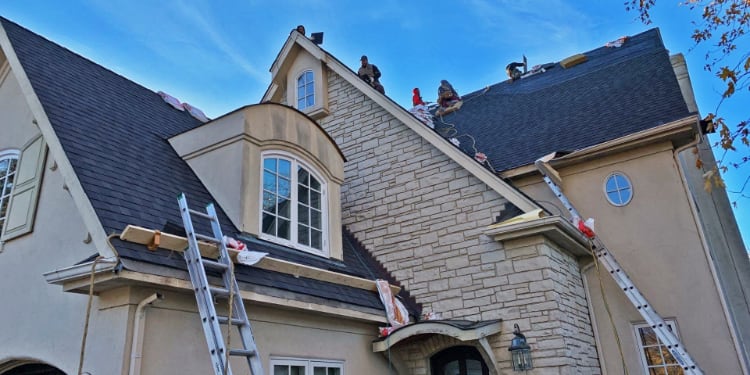
If you’re like most homeowners, you don’t have thousands of dollars sitting around waiting to be spent. Maybe you’ve got a small down payment available or maybe you have zero dollars to spend right now. In these situations, roof replacement financing becomes your only option.
First, you need to find a roof replacement company that offers financing, but that’s only a portion of the problem solving you need to consider, because you also need the contractor to be a proven expert at what they do, capable of handling your roof replacement without issue. Fortunately, most reputable roofing contractors offer financing options that will suit your needs.
Other options for paying for a new roof include a home equity loan, a home equity line of credit, a home improvement loan from your bank or if all else fails, a credit card to pay for the roof. The first options are generally low percentage financing loans, but credit card payments can be sky high, some with an APR of 30% or more, so that would be the option if everything else fails.
With due diligence, you will find the best option for your unique situation.
Roof financing explained
Your credit score/history will be a big determiner of what roof installation financing possibilities will be available to you. The terms you get might be quite different from what a family member, friend, neighbor or work colleague simply based on the differences in your credit score. Also, financing options will differ per lending body, so your best roof financing option won’t be discovered until you do plenty of research.
What is roof financing?
Roof financing is a convenient loan option tailored for homeowners and businesses seeking to cover the expenses of a new roof. It allows you to spread the cost over time, reducing financial strain. These options vary, with interest rates and terms determined by lenders. With roof financing, you can promptly address roofing issues, ensuring the safety and protection of your property from the elements.
Roof financing terms you need to know
If you’re new to roof financing, there is some language/terms you need to familiarize yourself with. The following are some of the basics to help get you started.
Terms
Definitions
Principal
The total sum of money you’re borrowing is known as the principal.
APR
APR stands for “annual percentage rate.” APR can vary from one borrower to the next, as well as from one financier to the next. APR is essentially what the lender charges you for the loan. When you compare one financing option to another, one of the most important elements is APR.
Term
The term is the amount of time (months or years) you have to repay your loan.
Interest
The interest is the sum of money you pay on top of your principal amount.
How does roof financing work?
When it’s time to replace your roof but you can’t pay for the total cost of the project all at once, roof financing will likely be the go-to option for you. Roof replacement financing provides you the means to get the work completed now and pay for it in installments over a predetermined amount of time.
Here’s a breakdown of how roof financing typically works:
Step 1: Choose your financing provider
Your roof financing could come from your roofing contractor, or a lender, such as a bank. You will choose the lender that offers you the most attractive conditions, which include the APR and the amount of time (term) you have to pay it back.
Step 2: Apply for financing
The application provides the lending entity information they need to determine if you’re eligible for financing and what your terms will be.
Step 3: Get approval and choose a financing plan
When the lending entity determines you are approved for a roofing loan, they will present you with the amount they can lend, the interest rate and the number of installments required to repay the loan.
Step 4: Schedule your roof replacement
After you’ve been approved for a loan and have chosen a plan, you can move forward with your roofing contractor and schedule dates for when the project will occur and the lender will release funds to the contractor.
Step 5: Make consistent payments
To stay current on your loan, make your monthly payments on time, because missing payments can have a negative impact on your credit rating. Also, depending on the details of your loan, missing payments could result in higher APR fees as a penalty. Defaulting on the loan could also result in your collateral (if negotiated during the loan application process) being repossessed.
Don’t let the roof financing process intimidate you. If you have questions, contact us at VIS Exterior and we will provide you all the answers you need.
How much does a new roof cost?
Roof replacement costs are determined by a variety of factors, including the size of your home/roof, the type of materials being used, how difficult the replacement will be and if the old roof is being removed.
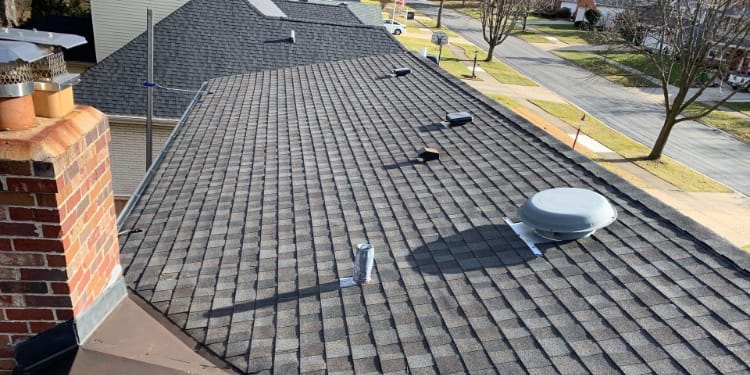
As for size, roofers refer to 100-square-feet of roof as one square. The average home has about 20 squares of area. Material costs are around $125 per square, but you also have to pay for labor, which is the most important aspect of the project, and that will cost you between $250 and $350 per square. This means the average roof can cost between $7,500 and $9,500, but it can also be much more if premium materials are being used and if the roof requires more than the usual amount of labor.
Why should you finance your roof replacement project?
It can be easy to neglect the roof. It’s not something you get a close look at very often, if ever, but there will come a day when the components of the roof can no longer keep the moisture out and it will need to be replaced. For some homeowners, the catalyst for a new roof project is a sudden storm that damages an otherwise functioning roof system.
It’s quite rare that a homeowner has built up a fund for a roof replacement, which is why so many roofing finance options are out there today. Many homeowners are under the impression that insurance will cover the bulk of the cost of a replacement, but they find out later that they need to cover a deductible, which can be a hefty sum.
There are benefits to financing, including the fact that it gives you some negotiating power regarding the amount that you will be paying for the replacement roof. Talk to your lender about how much of a down payment you need and negotiate with them. You can also negotiate the frequency of the payment or the amount of the payment every month.
The benefits of financing a new roof
If you’ve never financed a roof, don’t get spooked – there are benefits to doing this and it’s not a difficult process. Remember that when you finance, you’re getting something good – a new roof – for your home, which is probably the biggest investment you’ll make in your life and protecting it with a new roof just makes sense. The following are the perks you should focus on while researching your options.
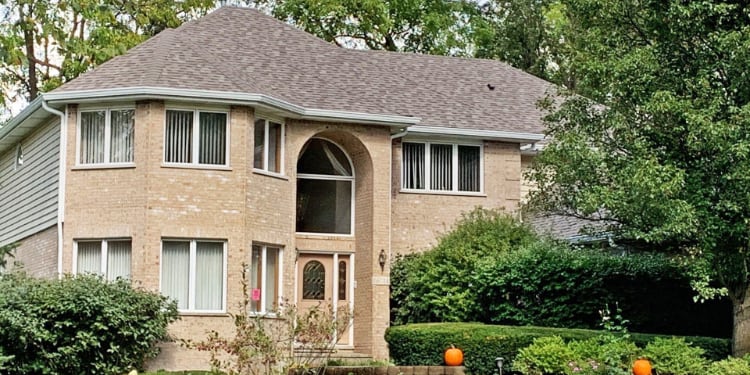
Roof now and pay later: That’s what roof financing is all about. Rather than waiting until you have funds saved up, which can take a long time and puts you at risk of considerable property damage if the roof is already leaking, you can get the project started now.
Is the rainy season coming soon? You need to get the roof repaired before you risk moisture damage to the interior of your home. Financing your roofing project gives you instant access to funds to get the project started and finished before the storms hit.
If your credit is good and you partner with the right lender or the right roofing contractor, you can take advantage of a no-interest roof financing option. The terms on 0% roof financing loans can vary, but many have a 12-month payback time frame, and that’s plenty of time for some homeowners to pay back their roofing loan.
At VIS Exterior, we offer a 12-month, no-interest option. When you take this option you don’t pay any fees, which means there is no interest to worry about – you’re only paying for the cost of the project.
Rather than worry about plunking down large sums of money every month for a loan tied to your roofing project, take advantage of low monthly payment plans that give you financial freedom. With small, affordable payments, you can chip away at your loan and not have the burden of coming up with a big lump sum of money at a given date.
As an independent roofing contractor, VIS Exterior is able to offer financing through EnerBank, which provides our clients the benefit of low monthly payments. These affordable installment plans align with our clients’ budgets and do not put them in a financial strain.
When offered a no upfront payment and no interest option, this will usually entail paying off the amount of the loan within a short timeframe, perhaps as little as six or twelve months. So, while you don’t have to put money down to get the work started, and while you won’t be tied to a monthly payment, you will be required to pay the full amount in a short window of time, which can be difficult to pull off on a tight budget, but the upside is that there are no extra fees tacked onto your balance.
Need a little time before you begin making payments on your new roof? Some lenders will offer clients the freedom of no payments over a set period of time. For homeowners who are short on cash, this gives them some leverage to build up reserves and/or to make financial plans for the repayment period, the terms of which will be whatever is agreed to between the lender and the homeowner.
The loan approval process has been fine tuned by contractors and lenders, as it’s something they assist customers with quite frequently. This means the roof replacement financing process is seamless, fast and efficient.
Loans can be applied for online – even on mobile devices. If you’re more comfortable talking it through with someone, you can also use your phone and get assistance from a financing professional. Just be ready to supply the required information and a signature and you’re set.
Afraid of debt? If so, you’re like many consumers who prefer to stay clear of financing in any form, but keep in mind that the high but necessary expense of a new roof is an investment that protects an even larger investment. Also, if you’re like most homeowners, you don’t have thousands of dollars on hand to completely pay for your new roof, so financing is the only option. And unlike many credit card lenders, the interest rates on roof financing won’t be sky high.
How to select the best way to pay for a new roof?
The best way to pay for a new roof is the one that’s most convenient to you, but for most homeowners, roofing loans tend to be the chosen route. And because there are quite a few options out there, the process can be intimidating. Roofing with financing makes a lot of sense, but for it to be in your best interests you need to do your research and find what’s available.
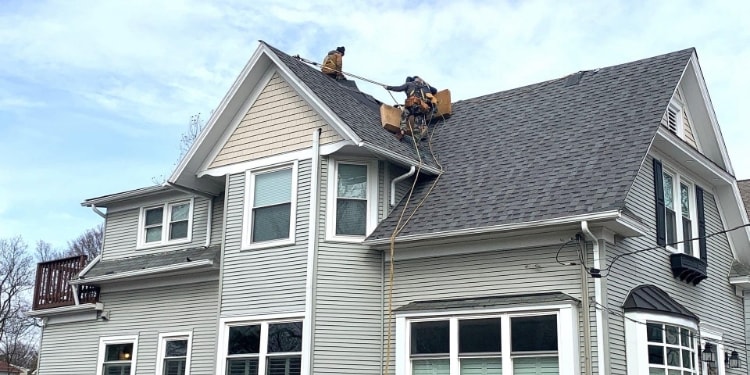
You might find the interest rates attractive on one financing option, but the repayment period doesn’t match your needs. Another option might have a suitable repayment schedule, but you are confident the interest could be better elsewhere. The more you research, the more options you’ll find, and you’ll eventually land on the one that is a good fit for you. The following information covers the most common financing options for homeowners taking on roofing projects.
Top 10 roof financing options
What might be a perfect fit for one homeowner won’t work for another. There are many reasons for this, from credit score differences to down payments to term agreements, but to ensure that you’re getting the best possible deal, talk to a financial advisor you trust – one that is impartial and will look out for what’s best for you and your budget.
Some of the following options will be familiar to you while others might be completely foreign. Hopefully, you’ll see one that gives you confidence moving forward with your reroofing project. To get a head start on the process, have a ballpark idea of the scope of your project, what it will cost you and what you’re comfortable spending. This will help guide you to options that you can afford.
Roof financing options to consider:
- Roofing companies that offer financing
- Credit cards
- Personal loan
- Home equity loan
- Home equity line of credit (HELOC)
- FHA Title 1 loan
- FHA 203K loan
- Homeowner’s insurance coverage after damage
- Home improvement store’s loan
- Cash-out refinancing
Check out the following for a more in-depth analysis of each of the most popular options for paying for a reroofing project.
Roofing companies that offer financing
With so many homeowners requiring financing, it’s something roofing companies are happy to offer. This streamlines the process, providing a one-stop shop for all the roofing and financing needs. Inquire with the contractors you’re considering about their financing options and you will begin to get a clearer picture of which one will work for you.
Many roofing contractors will extend two different options: A short-term loan with zero percent interest, the term of which is usually 12 months or less, or they will offer a longer repayment period, but with interest. If you fall into the camp that needs a term longer than a year to pay off the loan, you’ll need to carefully consider what the interest rates are for the longer terms.
One of the positive aspects about working with a company that offers financing, even if it’s through a third party, is that these are organizations that have been around long enough to establish trust in lenders, enough trust to work with them and their customers. This should instill confidence in you that if you do partner with them, they will perform exceptionally for you.
At VIS Exterior, we offer the 12-month, same as cash option that gives you an entire year to pay off your loan – interest free, but we also offer longer terms with a low APR of 6.99 percent. Contact us for more details about our roof financing options or check our Financing page for more information.
Take advantage of our great financing offers
NO payment
NO interest
Get 0% interest for 12 months
Credit cards
Credit cards are accepted by many roofing companies. However, a word of caution about using a credit card – the interest rates can be sky high, which means you’ll be responsible for the extra fees that can pile up and keep piling up until the balance is paid in full.
Putting a big expense on a credit card can also negatively impact your credit score, as the sudden accumulation of debt is frowned upon by major credit monitoring organizations like Equifax and Experian. A roofing project will also potentially max out a credit card.
If you know you can pay off your card before the interest rates begin to add on to your roofing costs (some credit cards offer an introductory interest-free period that can last a year or longer for those with great credit scores), then by all means go for it.
The convenience of credit card use, which doesn’t involve an application process, is attractive to some homeowners, but there are also rewards and perks (such as airline miles and cashback savings) offered by some credit card lenders that can also be attractive, especially on an expense as hefty as a new roof.
Personal loan
A personal loan for roof replacement costs is one of the preferred methods of paying for the project, mostly due to the fact that the interest rates are quite low. Most lenders will set up a monthly payment plan that matches the minimum you can pay over a set period of time, but as in most loan situations, paying it off as soon as possible is more financially prudent.
Roofing loans for homeowners with good credit can be a no-brainer, as you’ll not only be approved, but you’ll also be offered a lower interest rate than someone with fair or poor credit scores.
On the downside, homeowners who are still building up their credit and have some work to do to get it to “good” or “excellent” will most likely be denied or offered high-interest personal loans. A way around this is to offer collateral, which could lower your interest rate.
While it makes sense to inquire with your current bank about their personal loan products, branch out and ask other banks what they can offer you, as they could come back with something much more attractive.
Home equity loan
Lenders need to have assurances from those they do business with that the money they loan can be recouped, which is why they will offer a home equity loan for roof projects. The equity loan is a secured loan, which means the house is the collateral. These types of loans are popular because they generally carry a low-interest rate. However, you need to have positive equity in your home in order to qualify, which means you have probably owned the house for many years and have paid off a large sum of the home.
The terms of a home equity loan are usually set up for the lender to pay monthly installments over an expansive period of time, but the process of getting to that point can be time consuming, which is why you need to begin setting this up weeks in advance. However, once all the documents related to this type of loan are signed, the lender will send the money to your roofing contractor.
If putting up your home as collateral seems like a risky move, keep in mind that as long as you are able to make your payments, the lender will not take you home, yet that is the risk a homeowner takes when securing this type of loan.
Home equity line of credit (HELOC)
In industry speak, a home equity line of credit is simply referred to by its acronym – HELOC. So, how does this differ from a home equity loan? The answer is in how the money is dispersed to you. A HELOC allows you to use your home as collateral, but you get a line of credit compared to a home equity loan’s lump sum amount.
Typically, you’ll have 10 years to draw on this line of credit and pay it back as you go. For homeowners who have a roofing project, followed by a siding project, followed by replacing windows and gutters, the HELOC looks like a good option, as they can use their line of credit for each project.
The interest you pay will vary depending on the vendor, but it could be fixed, meaning it will remain the same over the entire term of the loan, or it could be variable, which means it can fluctuate up or down. Some lenders will offer low rates with a 20-year repayment period. The caveat to being eligible for a HELOC is that the value of the home must be 15 percent more than what you currently owe on it.
FHA Title 1 loan
Some fortunate homeowners will qualify for an FHA Title 1 loan, which is a U.S. government-backed loan. While you need to own your home to be eligible for the FHA Title 1 loan, you do not need to have built-up equity in it if the loan is $7,500 or lower. Another reason this loan is so sought after is that there is no credit score minimum requirement, and the loan is offered at a fixed rate.
And while there is no income requirement for this type of loan, you will need to have occupied the home for at least 90 days, have a debt-to-income ratio of less than 45 percent, you must own the home or have a long-term lease and you can only use the loan to replace the roof or make repairs to the existing one. You can also shop around as you look for a lender for your Title 1 loan, as the government simply insures the lender rather than actually lend the money directly.
According to the Department and Housing and Urban Development (HUD), the improvements made through a Title 1 loan must “substantially protect or improve the basic livability or utility of the property.” Also, the Title 1 loan can be used in conjunction with a 203(k) Rehabilitation Mortgage (see more about this in the section below). HUD warns applicants to beware of deceptive home improvement contractors, which is a good practice for homeowners getting any type of loan for any type of home improvement.
FHA 203K loan
Not everyone has built up equity in their home, or at least not enough to be eligible for some lenders’ programs, which is why they should consider an FHA 203(k) loan, which is another government-insured loan that can help pay for a new roof.
To be eligible, your home must be a one- to four-unit dwelling that is at least a year old. The typical credit score must be at least 580 to be eligible with a 3.5 percent down payment. The debt-to-income ratio must be below 43 percent, which means the applicant’s monthly debts, including the new mortgage payment, can’t go higher than 43 percent of the monthly income.
It’s recommended to work with a consultant to ensure the 203(k) application and process are handled correctly. This might include ensuring the contractor is capable of doing the work and the consultant might also oversee the progress of the project.
Homeowner’s insurance coverage after damage
Whether it’s a big storm that causes damage via fast-flying debris, a large tree limb falls on the roof or other reasons for damage, most home insurance policies will have arrangements for paying for at least part of the cost of fixing the damage.
The percentage of the repair costs covered depends on the insurance company and type of insurance coverage. The cause of the damage will also factor into what’s covered. If the damage is due to a storm, your roofing contractor should be able to inform you of that and also relay it to your insurance adjuster.
The homeowner is responsible for a deductible on any work that is required. This can range anywhere from $500 to $2,500 or more, and again, the amount of the deductible will vary from one policy to another. In most cases, the less a homeowner pays per month for their coverage, the higher the deductible will be.
Home improvement store’s loan
Most purchases from big box stores like Home Depot and Lowe’s are for materials that DIYers can use for minor home improvements. Roofing projects are best handled by trained professionals with years of experience behind them.
And while you won’t see a Home Depot home improvement loan, for homeowners with roofing experience, the credit program from Home Depot can be used to purchase materials for roofing projects. This financing program doesn’t include paying for labor, so if you’re contracting your labor, you’ll need to pay for that some other way.
Keep in mind that these financing programs can come at a high APR, which means if you’re paying the minimum every month, it could take years to pay off the debt.
A Lowe’s home improvement loan for your roofing project is a possibility. You can enter your contact information and your details about your project. You will then be connected with a Lowe’s associate, to discuss materials options and your budget. You will meet with a virtual roofing associate and go over your plans before an installation crew begins work.
Cash-out refinancing
Another financing strategy that is quite attractive to many homeowners is cash-out refinancing, which is a strategy where you refinance your mortgage for an amount greater than what you currently owe on your home, and then you receive the difference in cash, allowing you to pay “cash” for your roofing project.
If you’ve built up equity in your home and refinancing rates are attractive, this is a useful tool for generating money for all types of home improvement projects, including a new roof or major roof repairs.
Making a final decision: What is the best option to finance a roof?
There is no doubt that making the decision about how your new roof will be paid for is a big step and an important one. Focusing on which options have the lowest interest and best terms will help you make the right decision.
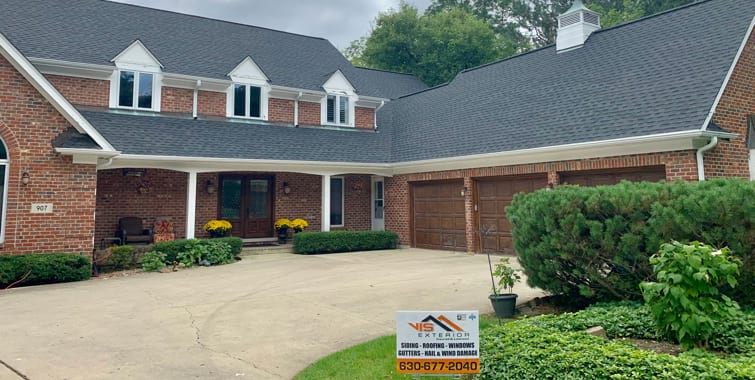
If the roof is damaged and leaks are present, there is less time to make this crucial decision, but that doesn’t mean you don’t have options. While using a credit card, which historically has the worst interest rates, might not seem attractive, sometimes it’s the only option.
Homeowners with good credit, ample savings and plenty of equity in their homes tend to have the best options, which means the project will be less of a financial hassle for them. But even if you don’t have outstanding credit and no money put aside for a major project, you could still be eligible for a low-cost loan, such as those provided through FHA.
Obviously, you want the option that allows you to pay the least amount of toward fees, but this can sometimes come with terms that give you 12 months or less to make pay off the loan. For homeowners who need more time and lower monthly payments, taking on a loan with terms that include fees (interest) is the only option.
If you need to get the project rolling sooner than later, you’ll also need to consider options that take less time. For example, your home is already at risk because of recent damage, which means going through all the paperwork involved in refinancing your home will not be an option, as the process takes too long (up to 45 days). A bank loan, on the other hand, only takes about a week.
Whichever decision you make, VIS Exterior is here to help you replace a roof with financing. Contact us for more information.
Why should you choose a local roofer with financing?
Most homeowners in the Chicago area have abundant choices in roofing contractors. This might seem like a luxury, but it can also be a source of stress because it can be difficult to determine which one is the best for your project. If this is the case with you, our tip is to go with local roofers that offer financing.
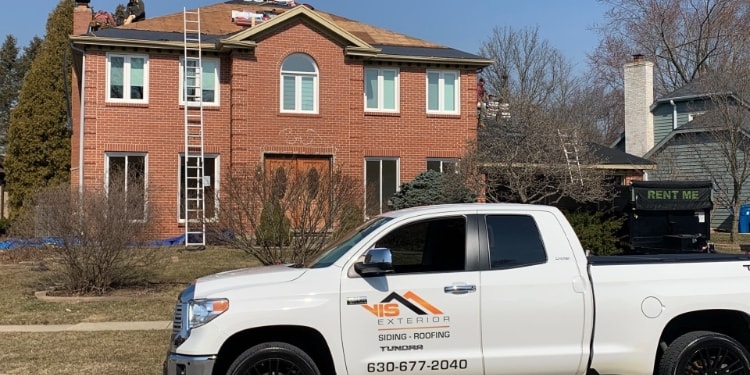
When you can get on a roof replacement payment plan with a trusted group of local roofers, you’re going to be in really good hands. Roofers that finance have the backing of lenders who trust them with their money. That means these contractors are proving themselves project after project, impressing homeowners with their skills.
Roofers that finance also save homeowners the extra steps involved in taking on large projects like these. Instead of shopping around for roofers and then separately for lenders, which can be time consuming on both accounts, everything you need is under one roof.
Hire a reputable roofing contractor with financing in the DuPage County
VIS Exterior is the preferred roofing contractor with financing in DuPage County. We are a company that values our loyal customers, as we’re local roofers who live and work among our clients, so it’s a pleasure to be able to offer financing options that help them get what they need.
In fact, we offer our customers flexible payments that fit their financial planning. Instead of having to make big expenditures that strap their budgets, they come to us and choose a financing option that gives them the wiggle room they need to make ends meet while getting a new roof that protects their home and everything in it.
Do other contractors offer financing? Yes, but when you partner with VIS Exterior, you get the advantage of an experienced team of roofers who are experts at installing all types of roofing systems on all types of homes. Plus, we make the financing application process quick and easy so you get the money you need fast.
Want to avoid up-front costs? Partner with VIS Exterior, because even homeowners with credit concerns can avoid costly up-front payments, even those with a FICO down to 580! No equity is required for our loans, which range up to $45,000. If your loan is $20,000 or less, you don’t need proof of income.
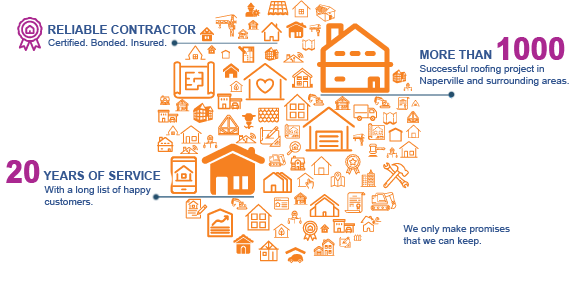
Frequently asked questions about roof financing
If you’re embarking on a roofing project, you probably have plenty of questions about roof financing. Fortunately, we’re here to provide the answers to get you on the right track so your project can begin sooner than later, and with financing with terms that meet your needs.
Is roof financing the right choice for you?
Once you’ve established your budget you get a better idea of what roof financing options will work for you. Roof financing is much easier to plan when you know what you can spend, and this also helps determine the type of materials used in your project.
It’s easier to communicate with your contractor about how your project will play out when you have a ballpark idea of your budget, and a contractor with financing will also be able to help you choose the option that best fits your budget.
Is roof financing for you? If you’re like most homeowners who don’t have thousands of extra dollars to spend right now, the answer is “yes.” Avoid the stress that a big expenditure can create by finding a local reputable roofer with financing that gets you the roof you need now while paying for it over time.
How long can you finance a roof for?
New roof financing options will vary per lender and per homeowner. For example, if you’re able to make larger monthly payments over the course of 12 months and completely pay off your loan, you might get a 0 percent APR, which means you’re not paying any fees.
Some homeowners prefer to really stretch out those payments over the course of multiple years, which means they’re going to incur fees in the form of interest, but the monthly payments are low. If you’ve tied your loan into a home refinancing agreement, the payments could go on for 20 years. Financing through a roofer could include terms anywhere from three to 10 years.
Do roofers offer payment plans?
Roofers with payment plans are highly sought-after for homeowners, as this makes the cost of a new roof affordable. In fact, roofing companies that provide financing offer a valuable service that can take the stress out of a project, because wrapping all the financing and project planning into one entity makes the process go so much smoother.
How quickly can you get a roofing loan?
The speed at which you can obtain financing for your new roof will vary depending on the type of loan. For example, refinancing to generate money for your project can take as long as 45 days, but you can get approval from a traditional lender in minutes.
New roof financing through a roofing contractor is almost always an easy process. Most contractors will work with a lending agency that provides them with online tools for clients to easily complete their application process. Homeowners find out very quickly what roofing loans are available and the terms for repayment, as well as the interest.
Can you finance a roof with bad credit?
You can finance a roof with bad credit, but your options will be limited. If you’re in the process of building up your credit, seek out a lender that will allow you to bring in a cosigner with good credit to help you secure the loan. Also, if you have collateral you can put up, you’re likely to attract lenders who will provide you with financing options. Keep in mind that if you miss payments and default on your loan, the lender can repossess your collateral.
Can my insurance pay for a new roof?
When a homeowner realizes their roof needs to be replaced, one of the first questions they have is, “how do I get my insurance to pay for a roof replacement?” If you’ve chosen the right policy, you’ll be in luck. For example, if you’ve picked a policy that has a high monthly premium, there is a good chance your deductible will be low, which means the insurance company will foot the bill for the majority of the project cost.
At VIS Exterior, we have worked with many insurance agencies and adjusters and we will communicate with them on your behalf to ensure you’re getting everything you are afforded under your current policy.
What are the differences between home equity loans and HELOC loans?
A home equity line of credit (HELOC) differs from a home equity loan in that a HELOC is more flexible. For example, a HELOC allows you to repeatedly withdraw money over time, whereas a home equity loan is a one-time fixed amount. With a HELOC, your repayment will evolve as the amount you borrow evolves. The caveat here is that with a HELOC, you’re probably going to get less favorable terms than what is offered to you through a home equity loan.
If you have a roofing project and other home improvement projects lined up after, you might be more inclined to seek out a HELOC. If the only project on your horizon is a new roof, a home equity loan is probably going to be more favorable. To ensure you’re making the right decision, work with a financial advisor to guide you.
How much more expensive will a roof be with financing vs. cash?
“Same as cash” deals are out there and they are legitimate. For example, at VIS Exterior, we offer financing that gives you 12 months to pay back your borrowed amount and if you honor that schedule, there are no fees associated. However, if you require more than 12 months to pay back what you borrowed, there are associated financing fees. Keep in mind that financing via a credit card, which is an option, is likely going to be far, far more expensive in the long run than financing offered through VIS Exterior’s multi-year option, as our rates are low.
What are the pros of roof loans?
The most obvious benefit to receiving a roofing loan is that you get the roof you need now and pay for it over time. The faster you pay it off, the less you pay in fees (sometimes you pay zero fees on loans with terms of 12 months and under).
Roofing loan pros:
- Low rates: Rather than using a credit card with rates up to 30 percent, consider a roofing loan with a low APR.
- No collateral: Qualified homeowners don’t need to put up collateral and risk losing it should they go into default.
- Fast money: While a home refinancing can take more than a month, roofing loans are super fast.
What are the cons of roof loans?
While loans are super convenient, they can cost you more money than the actual original project itself. That’s because the lender is a business and makes money via fees they charge for their services. Generally speaking, roofing loans have higher rates than home equity loans, and if you don’t have collateral to put up, you’re going to pay an even higher rate. Another detraction from roofing loans compared to home equity financing is that you don’t get a tax deduction with a roofing loan.
Does a new roof increase home value?
As homeowners ponder replacing their roof, the question arises: does a new roof increase home value? The resounding answer is “yes!” Most homeowners will usually see a 60 to 65 percent return on their investment. A new roof adds years of protection to the home, which boosts its resale value, but there is also the curb appeal to consider. Finally, there is value related to the savings a new roof brings in the form of lower utility bills.












